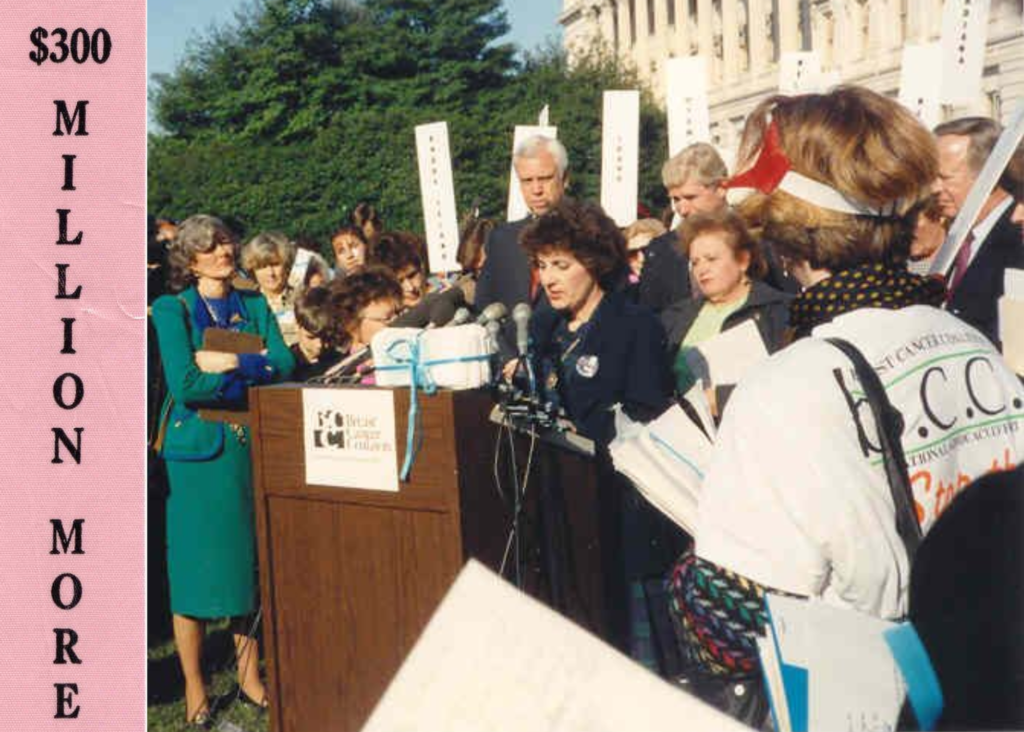 In 1992, in response to grassroots advocacy led by the National Breast Cancer Coalition (NBCC), Congress established the Department of Defense peer-reviewed Breast Cancer Research Program (DOD BCRP). Since then, Congress has appropriated more than $4.3 billion to support this vital initiative. These funds have driven lifesaving and transformative discoveries in breast cancer research.
In 1992, in response to grassroots advocacy led by the National Breast Cancer Coalition (NBCC), Congress established the Department of Defense peer-reviewed Breast Cancer Research Program (DOD BCRP). Since then, Congress has appropriated more than $4.3 billion to support this vital initiative. These funds have driven lifesaving and transformative discoveries in breast cancer research.
To date, the program has awarded over 7,358 competitive grants, contributing to the development of 25 commercialized products and resources, and supporting more than 50 promising therapies currently in clinical trials or under development. The program has resulted in more than 1,300 patents and 19,500 publications in scientific journals. The impact of this work spans all facets of breast cancer, improving outcomes for millions of individuals—including members of the military and their families.
A defining feature of the DOD BCRP is its rigorous two-tier application review process, which brings together scientists, clinicians, military personnel, and educated consumers from the breast cancer community. In addition, trained breast cancer advocates are involved throughout the research continuum, ensuring that the research remains relevant, patient-centered, and grounded in the real-world experiences of those affected by the disease.
 The DOD BCRP was created in response to NBCC’s “$300 Million More” campaign.
The DOD BCRP was created in response to NBCC’s “$300 Million More” campaign.Drug name: Trastuzumab (Herceptin)
Type of breast cancer treated: HER2+ (HER2=Human Epidermal Growth Factor Receptor 2)
How does it work? Herceptin is a monoclonal antibody that targets HER2, a protein found in excess on some breast cancer cells. It works by blocking cancer cell growth and signaling the immune system to attack the tumor. At the time of its development, many were skeptical—previous antibody therapies had failed. But with critical support from the DOD BCRP, Herceptin defied expectations. It became the first targeted therapy to dramatically change outcomes for a specific subtype of breast cancer and is now a cornerstone of treatment for HER2-positive disease.
Impact: Over 25 years of transforming care. More than 2.4 million people treated worldwide. Herceptin didn’t just extend lives—it fundamentally changed them. Once considered one of the most aggressive forms of breast cancer, HER2-positive disease is now one of the most treatable, thanks to this groundbreaking therapy.
Legacy: Herceptin marked the beginning of a new era in oncology. It proved that targeting the molecular drivers of cancer could lead to more effective, personalized treatment—and it set the standard for how we develop and deliver cancer therapies today. Its success inspired an entire class of HER2-targeted drugs, reshaped clinical trial design, and fueled global efforts to ensure equitable access to life-saving treatments. Herceptin’s legacy continues to influence cancer care and research around the world.
Drug name: Palbociclib (Ibrance), Ribociclib (Kisqali), and Abemaciclib (Verzenio)
Type of breast cancer treated: HR+ HER2- (HR=hormone receptor [estrogen and/or progesterone])
How does it work? Rather than directly killing the cancer cells, CDK4/6 inhibitors work by blocking the proteins that allow cancer cells to grow and divide. This helps to slow or stop cancer’s ability to proliferate.
Impact: Ibrance was the first new treatment option in over a decade for this subtype of breast cancer and has been used to treat more than 450,000 breast cancer patients. Following its approval, Kisqali and Verzenio were introduced, offering additional, meaningful benefits—most notably, the potential to help patients live longer.

Drug name: Tamoxifen (Nolvadex)
Type of breast cancer treated: ER+ (ER=estrogen receptor)
How does it work? Tamoxifen is a type of hormone therapy that blocks estrogen from fueling the growth of cancer cells. It works by binding to estrogen receptors, preventing estrogen itself from attaching and stimulating cancer growth.
Impact: Tamoxifen significantly reduces the risk of breast cancer recurrence and death in people with ER+ disease. The ATLAS clinical trial—supported in part by funding from the DOD BCRP—showed extending tamoxifen treatment from 5 to 10 years can further enhance its benefits, cutting breast cancer mortality in half during the second decade after diagnosis.
Type of breast cancer treated: Early stage
How does it work? Radiotherapy uses radiation to kill cancer cells and can decrease the risk of cancer returning, but the radiation can damage surrounding healthy tissue.
Impact: In DOD BCRP-funded projects, researchers found that providing radiotherapy to a patient in the prone position (facing down) instead of the supine position (facing up) can spare the heart and lungs from significant radiation exposure.
Goal: Stimulate or alter the patient’s immune system to help their immune cells to kill cancer cells currently in their body, train their immune cells to prevent breast cancer cells from returning, or prevent breast cancer in the first place.
The potential: 22 products are in clinical trials, with 1 product in the final stage of the clinical pipeline (Phase 3 trial).
Goal: Kill cancer cells, stop cancer cells from growing and spreading, or prevent breast cancer in the first place, with minimal toxicity and maximal benefits.
The potential: More than 30 treatments are in clinical trials, with 3 new treatments in the final stage of the clinical pipeline (Phase 3 trial). Importantly, beyond the clinical pipeline, several treatments in this area have made it to the market and are currently used to treat breast cancer patients.
Goal: Create sensitive and accurate technologies for determining one’s risk of breast cancer, why and how some breast cancers become metastatic, and distinguishing deadly from non-deadly breast cancer.
The potential: 3 products are currently in clinical trials. Importantly, beyond the clinical pipeline, more than 10 products in this area have made it to the market and are currently used to diagnose, evaluate risk of, or predict best treatment plans for breast cancer.
